
Lawrence Welk was an American accordionist, bandleader, and television impresario, who hosted The Lawrence Welk Show from 1951 to 1982. His style came to be known as "champagne music" to his radio, television, and live-performance audiences.

Strasburg is a historically German speaking village in Emmons County, North Dakota, United States. The population was 379 at the 2020 census. Strasburg was founded in 1902.

Myron Floren was an American musician best known as the accordionist on The Lawrence Welk Show between 1950 and 1980. Floren came to prominence primarily from his regular appearances on the weekly television series in which Lawrence Welk dubbed him as "the happy Norwegian," which was also attributed to Peter Friello.

Abraham Lincoln Birthplace National Historical Park is a designated U.S. historic park preserving two separate farm sites in LaRue County, Kentucky, where Abraham Lincoln was born and lived early in his childhood. He was born at the Sinking Spring site south of Hodgenville and remained there until the family moved to the Knob Creek Farm northeast of Hodgenville when he was two years old, living there until he was seven years of age. The park's visitor center is located at the Sinking Spring site.

Watters Smith Memorial State Park is a 532-acre (2.15 km2) historical park and national historic district with a pioneer homestead and museum located in Harrison County, West Virginia. The homestead, rising above Duck Creek, is a memorial to settler Watters Smith, who was born in Trenton, New Jersey, in 1767, and moved to Harrison County in what was then Virginia, in 1796, with his wife Elizabeth Davisson Smith. A log cabin similar to the original was moved and reconstructed on the park, together with farm buildings typical of early 19th century settlement. The more modern Smith family home has been restored as a museum, and an additional museum houses many local farm artifacts from earlier eras. Guided tours are offered from Memorial Day weekend through Labor Day. In addition, the park features swimming, picnicking, hiking trails, and horseback riding.

West Overton is located approximately 40 miles (64 km) southeast of Pittsburgh, in East Huntingdon Township, Westmoreland County, Pennsylvania, United States. It is on PA 819 between the towns of Mount Pleasant and Scottdale. Its latitude is 40.117N and its longitude is -79.564W.
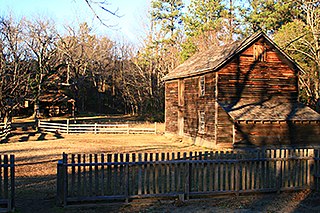
Duke Homestead State Historic Site is a state historic site and National Historic Landmark in Durham, North Carolina. The site belongs to the North Carolina Department of Natural and Cultural resources and commemorates the place where Washington Duke founded the nation's largest early-20th-century tobacco firm, the American Tobacco Company.
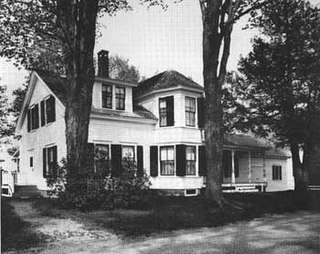
The Coolidge Homestead, also known as Calvin Coolidge Homestead District or President Calvin Coolidge State Historic Site, was the childhood home of the 30th president of the United States, Calvin Coolidge and the place where he first took the presidential oath of office. Located in Plymouth Notch, Vermont, Coolidge lived there from age four in 1876 to 1887, when he departed for Black River Academy for education. He is buried in Plymouth Notch Cemetery not far from the home.
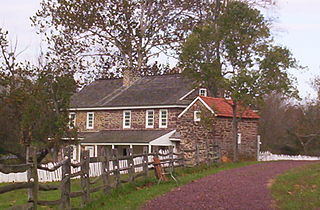
The Daniel Boone Homestead, the birthplace of American frontiersman Daniel Boone, is a museum and historic house that is administered by the Friends of the Daniel Boone Homestead near Birdsboro in Berks County, Pennsylvania. It is located on nearly 600 acres (2.4 km2) and is the largest site owned by the Pennsylvania Historical and Museum Commission. The staff at Daniel Boone Homestead interpret the lives of the three main families that lived at the Homestead: the Boones, the Maugridges and the DeTurks. The park is just off U.S. Route 422 north of Birdsboro in Exeter Township.

The Frederick A. and Sophia Bagg Bonanza Farm, also known as Bagg Bonanza Farm or F. A. Bagg Farm, is a former bonanza farm in Richland County, North Dakota, United States. Operated between about 1915 and 1935, the farm of the Baggs encompasses as many as 7,000 acres (2,800 ha), and was operated virtually like a factory according to modern business practices of the period. The surviving farm complex is now owned by a local non-profit organization and operates as a museum. It is one of the best-preserved examples of a bonanza farm complex in the nation, and was declared a National Historic Landmark in 2005. It is located approximately 1 mile (1.6 km) south of Mooreton.

Forge Farm is an historic farm in Warwick, Rhode Island. Established in the mid-17th century by the Greene family, it is one of the oldest farms in Rhode Island. It was the birthplace of General Nathanael Greene, a prominent American general in the American Revolutionary War. The core of the main house was built in 1684 by James Greene, son of John Greene, who purchased the land from local Native Americans. It has been extended and altered numerous times in the 18th and 19th centuries. Nathanael Greene was born in this house in 1742, and the farm was owned for many years by Nathanael's brother Christopher, and wife, Deborah (Ward) Greene, daughter of Continental Congress member Samuel Ward.
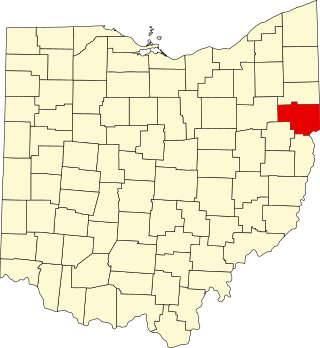
This is a list of the National Register of Historic Places listings in Columbiana County, Ohio.

The Frawley Ranch is an historic ranch in Lawrence County, South Dakota, near Spearfish, South Dakota. Henry Frawley developed what became the largest and most successful cattle ranch in western South Dakota by purchasing lands that had failed as smaller homesteading parcels. The property was declared a National Historic Landmark in 1977.

The House at 15 Lawrence Street in Wakefield, Massachusetts is a well-preserved Queen Anne house with a locally rare surviving carriage house. It was built in the early 1870s, and was listed on the National Register of Historic Places in 1989.

The House at 20 Lawrence Street in Wakefield, Massachusetts is a complex residential structure with elements of Queen Anne, Stick style, and Colonial Revival style. Built about 1880, it was listed on the National Register of Historic Places in 1989.

The McClelland Homestead is a historic farm in western Lawrence County, Pennsylvania, United States. Located along McClelland Road northeast of Bessemer, the farm complex includes buildings constructed in the middle of the 19th century. It has been designated a historic site because of its well-preserved architecture.

The Prairie Homestead is a sod house located at 21070 South Dakota Highway 240 north of Interior, South Dakota. The house was constructed by Ed Brown and his wife in 1909. The Browns built their home with sod bricks and topped it with a grass roof. Western South Dakota was one of the last regions of the state to be settled by homesteaders, and the house is now one of the few remaining sod homes in the state. The home is now open to visitors for tours and houses farm animals and prairie dogs on its grounds.
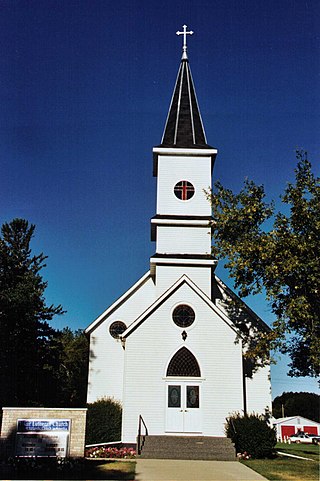
The Vikur Lutheran Church at Mountain is an historic Lutheran church building in Mountain, Pembina County, North Dakota. Built in 1885, it is the oldest Icelandic Lutheran church in the United States. The Gothic Revival wood-frame building was built in land donated in 1881 by the pastor Páll Thorláksson, who was influential in establishing the Icelandic American community in the area, and who died in 1882, before its construction. Most of the wood used to build Vikur Lutheran Church at Mountain came from the land owned by Friðbjörn Björnsson, who emigrated from Iceland in 1873, leaving from the farm Baldursheimur in Möðruvallaklaustur Parish, Eyjafjarðarsysla, and homesteaded east of Mountain on Cart Creek in 1881.
The Ashley Jewish Homesteaders Cemetery is an early 20th century burial site near Ashley, North Dakota. The Russian and Romanian Jews who farmed the area beginning in 1905 arrived as refugees fleeing pogroms and persecution. They had never farmed before, due to restrictions against Jews owning land in their native countries. Despite this lack of experience and the many rocks and boulders that peppered their claims, with the assistance of their German-Russian neighbors, and hard work and persistence, the great majority of them were successful enough to buy their land outright prior to the five-year waiting period contained within the Homestead Act of 1862, or to own their land at the five year mark.
The Freborg Homestead near Underwood in McLean County, North Dakota was listed on the National Register of Historic Places in 2014. The listed property is 10.5 acres (4.2 ha) that includes the farm buildings, out of what once was a 160 acres (0.65 km2) homestead.




















